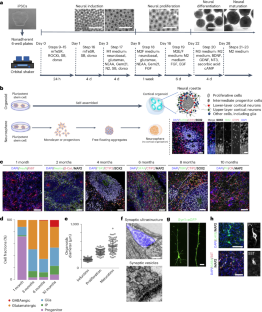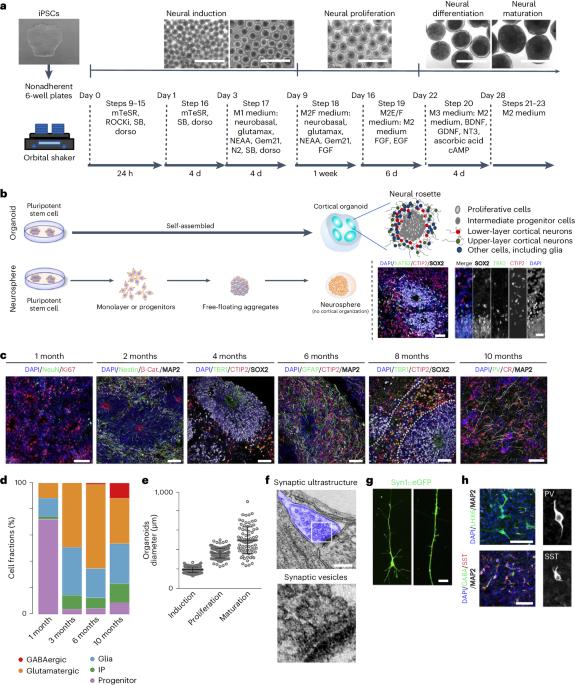生成具有复杂神经振荡的 "半引导 "皮层有机体
IF 13.1
1区 生物学
Q1 BIOCHEMICAL RESEARCH METHODS
引用次数: 0
摘要
神经电生理学的时间发展遵循遗传编程,类似于发育过程中的细胞成熟和组织。这种电生理学发展的新特性,即神经振荡,可用于描述大脑发育的特征。最近,我们利用人类基因组编码的先天编程生成了功能成熟的皮质器官组织。简而言之,干细胞通过连续振荡悬浮在培养液中,自然聚集成胚状体,然后暴露在培养基配方中进行神经诱导、分化和成熟。特定的培养形式、培养基成分和暴露于这些培养基的持续时间区分了类器官方案,并决定了该方案是引导性的还是非引导性的,以实现特定的神经命运。这里介绍的 "半引导 "方案与大多数引导型方案相比,诱导和分化步骤较短,特异性模式化分子较少,但与非引导型方案不同的是,它仍然使用神经营养因子,如脑源性生长因子和神经营养素-3。这种方法既能获得无引导方法的细胞类型多样性,又能保持疾病建模的可重复性。重要的是,我们对这些有机体的电生理学进行了表征,发现它们再现了在发育中的人脑中观察到的神经振荡的成熟过程,这是其他方法没有显示的特征。该方案代表了将分子和细胞生物学与人类认知联系起来的第一步,它已被用于发现人类大脑发育、进化和神经系统疾病的基本特征。有经验的细胞培养技术人员可望用 1 个月时间完成该方案,并可选择扩展成熟、电生理记录和腺相关病毒转导程序。本文章由计算机程序翻译,如有差异,请以英文原文为准。


Generation of ‘semi-guided’ cortical organoids with complex neural oscillations
Temporal development of neural electrophysiology follows genetic programming, similar to cellular maturation and organization during development. The emergent properties of this electrophysiological development, namely neural oscillations, can be used to characterize brain development. Recently, we utilized the innate programming encoded in the human genome to generate functionally mature cortical organoids. In brief, stem cells are suspended in culture via continuous shaking and naturally aggregate into embryoid bodies before being exposed to media formulations for neural induction, differentiation and maturation. The specific culture format, media composition and duration of exposure to these media distinguish organoid protocols and determine whether a protocol is guided or unguided toward specific neural fate. The ‘semi-guided’ protocol presented here has shorter induction and differentiation steps with less-specific patterning molecules than most guided protocols but maintains the use of neurotrophic factors such as brain-derived growth factor and neurotrophin-3, unlike unguided approaches. This approach yields the cell type diversity of unguided approaches while maintaining reproducibility for disease modeling. Importantly, we characterized the electrophysiology of these organoids and found that they recapitulate the maturation of neural oscillations observed in the developing human brain, a feature not shown with other approaches. This protocol represents the potential first steps toward bridging molecular and cellular biology to human cognition, and it has already been used to discover underlying features of human brain development, evolution and neurological conditions. Experienced cell culture technicians can expect the protocol to take 1 month, with extended maturation, electrophysiology recording, and adeno-associated virus transduction procedure options. This protocol details the generation of cortical organoids with complex neural oscillations through a ‘semi-guided’ protocol, and their functional characterization using microelectrode array measurements, calcium imaging and adeno-associated virus transduction.
求助全文
通过发布文献求助,成功后即可免费获取论文全文。
去求助
来源期刊

Nature Protocols
生物-生化研究方法
CiteScore
29.10
自引率
0.70%
发文量
128
审稿时长
4 months
期刊介绍:
Nature Protocols focuses on publishing protocols used to address significant biological and biomedical science research questions, including methods grounded in physics and chemistry with practical applications to biological problems. The journal caters to a primary audience of research scientists and, as such, exclusively publishes protocols with research applications. Protocols primarily aimed at influencing patient management and treatment decisions are not featured.
The specific techniques covered encompass a wide range, including but not limited to: Biochemistry, Cell biology, Cell culture, Chemical modification, Computational biology, Developmental biology, Epigenomics, Genetic analysis, Genetic modification, Genomics, Imaging, Immunology, Isolation, purification, and separation, Lipidomics, Metabolomics, Microbiology, Model organisms, Nanotechnology, Neuroscience, Nucleic-acid-based molecular biology, Pharmacology, Plant biology, Protein analysis, Proteomics, Spectroscopy, Structural biology, Synthetic chemistry, Tissue culture, Toxicology, and Virology.
 求助内容:
求助内容: 应助结果提醒方式:
应助结果提醒方式:


